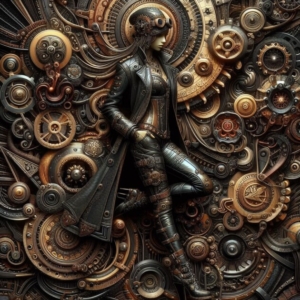SUSTAINABILITY AND AUTOMOTIVE LEATHER IN THE FASHION INDUSTRY
SUSTAINABILITY AND AUTOMOTIVE LEATHER IN THE FASHION INDUSTRY
Peralta Clothing, Sustainable Leather:
The Future of the new wave of Fashion and Small Leather Goods Industry.
Abstract
This technical paper explores the growing trend of sustainable leather sourcing within the fashion and small leather goods industry. The current landscape of sustainable leather sourcing, the challenges and opportunities faced by the new wave of Fashion and small leather goods companies, the potential benefits of upcycled automotive leather. By understanding these factors, businesses can make informed decisions that promote sustainability and drive success in the evolving market. As environmental and ethical concerns become more prominent, Peralta Clothing is turning to alternative materials and production methods to meet our standards and consumer demand for sustainable products. This paper examines the rise of sustainable leather sourcing from the automotive industry, the challenges and opportunities for fashion and small leather goods companies outside Peralta Clothing, and the potential of upcycled automotive leather as a sustainable solution.
Introduction
As Peralta Clothing strives to be more conscious about their environmental impact, automotive leather sourcing has gained traction. With growing concerns around the sustainability businesses are increasingly sourcing or creating materials that offer viable, stylish, and cost-effective alternatives to traditional leather sourcing. Understanding the benefits, drawbacks, and applications of these environmentally friendly leather offerings can help business owners make smarter decisions with lasting impacts.
The Rise of Sustainable Automotive Leather Sourcing
Leather goods, in particular, are facing a shift in consumer demand as more people become aware of the environmental and ethical concerns surrounding traditional leather production. Peralta Clothing is already using alternative materials and production methods to meet the growing demand for environmentally friendly and socially responsible in its leather products.
The Rise of Sustainable Leather design with the help of AI Tools:
Using AI and 3D tools, we can create a digital Fashion Collection, we like to document the steps from the beginning mud boards, brain storming and other methods. Usually, we see the results of the collection partially, we can include board work and 3D experiments. The tools we use normally are stable diffusion, Pinterest, Catia V5 and Blender to generate all details. These tools allow us to generate a fusion of human and non-human Parts. At Peralta Clothing we are really excited about the development of our collection and let’s see where these tools are. Taking our creativity to another level.
Alternative Materials
Upcycled automotive real Leather: Made to meet automotive standards is a perfect match for our needs to build products that last at least 30 years using them daily.
As consumers become more conscious of their impact on the environment and society, the demand for environmentally friendly and socially responsible leather products will continue to grow. Since our creation Peralta Clothing is offering sustainable and ethical options to be better positioned to meet the needs of their customers.
Challenges Faced by Fashion and Small Leather Goods Companies
Fashion and Small leather goods companies face several challenges in meeting the increasing demand for sustainable products like automotive leather, this is big problem because automotive leather will be only used by automakers during cars manufacturing with limited access for companies outside the automotive world.
Cost
– Higher Material Costs: Alternative materials such as vegan and eco-leather can be more expensive than traditional and automotive upcycled leather.
– Production Transition: Implementing sustainable and ethical production methods may require significant investment in new technologies and processes.
– Supply Chain Standards: Ensuring ethical treatment of animals and sustainable sourcing can incur additional costs and resources.
Consumer Awareness
– Education and Outreach: Small companies may struggle to educate consumers about their sustainable practices compared to larger companies with more extensive marketing resources.
Opportunities for Sustainable Leather Goods Companies
Despite the challenges, there are several opportunities for companies that can meet the demand for sustainable products.
Differentiation
– Unique Products: Small companies can differentiate themselves by offering unique and innovative sustainable products made with upcycled automotive leather
– Agility and Flexibility: Smaller companies can experiment with new materials and production methods that larger companies may be hesitant to explore.
Consumer Loyalty
– Transparency: Consumers may be more likely to choose small companies that are transparent about their sustainable practices.
– Trust and Loyalty: Building a reputation for sustainability can lead to increased consumer loyalty and trust.
Funding and Resources
– Government Grants: Access to government grants and subsidies for sustainable practices.
– Ethical Investors: Investment from ethical investors who prioritize sustainability.
– Crowdfunding: Opportunities to raise funds through crowdfunding platforms that support sustainable initiatives.
Upcycled Automotive Leather: A Sustainable Solution
One promising approach to sustainable leather sourcing is the use of upcycled automotive leather. This involves repurposing leftover leather from the automotive industry, which would otherwise go to incinerators and landfills increasing the CO2 Production, to create high-quality leather goods.
Pros and Cons of Upcycled Automotive Leather
| Upcycled Automotive Leather | |
| Pros | Cons |
| Benefits:
Reduces waste by repurposing automotive leather. |
Limited Availability:
Supply of upcycled leather may be inconsistent. |
| Cost-Effective:
Utilizes existing materials, potentially lowering costs. |
Quality Variability:
Upcycled leather may have inconsistencies in quality. |
| Ethical:
Reduces the need for new animal hides, promoting animal welfare. |
Processing Challenges:
Requires specialized processes to prepare leather for reuse. |
| Unique Aesthetic:
Offers a distinctive look that can differentiate products. |
Consumer Perception:
Some consumers may have reservations about upcycled materials. |
| Support for Circular Economy:
Encourages sustainable production and consumption patterns. |
Supply Chain Complexity:
Coordinating with automotive suppliers can be complex. |
Personal Conclusions:
The Fashion and small leather goods industry is undergoing a significant transformation as companies respond to the growing demand for sustainable and ethical products. While there are challenges in terms of cost, consumer awareness, and supply chain management, there are also substantial opportunities for differentiation, consumer loyalty, and access to funding. Upcycled automotive leather represents a viable and innovative solution that aligns with sustainability goals. By embracing these sustainable practices, new Fashion and new small leather goods companies can contribute to a more sustainable future while meeting the evolving needs of their customers.




